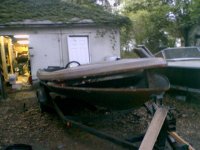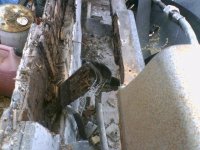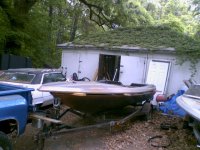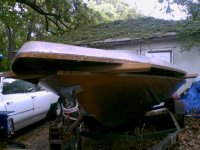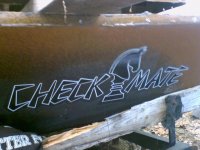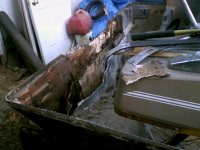Kary
Active member
Seperating the deck
I just seperated the deck on my MX15 and had a tough time with the splashwell, too. I have a forbe(a 2X3 glassed to the transom inside) and had to cut it to gain prybar access under and between the splashwell. Seperate the top seam of the deck from the transom from the rear. I took a 5' 1X1 and raised the deck at the center of the bow up front to make the splashwell pull a little as I used an airsaw(or sawzall) to cut the inner transom skin of glass and mat at the joining area only about a 1/4" deep. Be careful not to cut the skin(gelcoat). I took a snapon prybar(other brands will work) and pryed VERY carefully until I heard it start seperating and popping. The 1X1 did the rest as I GENTLY pried it apart from the bottom of the splashwell away from the trasnsom. I did this AFTER I seperated the top seam of the deck from the transom from the rear. Mine started popping and as I took the prybar and started seperating and helping it along it POPPED off and the whole deck jumped to the side(I didn't have anyone there to hold it just in case) and landed a little swauker jawed on the hull.....be careful, it jumps off and shifts...have someone hold it to steady it as it pops apart. I hope this helps ya.
I just seperated the deck on my MX15 and had a tough time with the splashwell, too. I have a forbe(a 2X3 glassed to the transom inside) and had to cut it to gain prybar access under and between the splashwell. Seperate the top seam of the deck from the transom from the rear. I took a 5' 1X1 and raised the deck at the center of the bow up front to make the splashwell pull a little as I used an airsaw(or sawzall) to cut the inner transom skin of glass and mat at the joining area only about a 1/4" deep. Be careful not to cut the skin(gelcoat). I took a snapon prybar(other brands will work) and pryed VERY carefully until I heard it start seperating and popping. The 1X1 did the rest as I GENTLY pried it apart from the bottom of the splashwell away from the trasnsom. I did this AFTER I seperated the top seam of the deck from the transom from the rear. Mine started popping and as I took the prybar and started seperating and helping it along it POPPED off and the whole deck jumped to the side(I didn't have anyone there to hold it just in case) and landed a little swauker jawed on the hull.....be careful, it jumps off and shifts...have someone hold it to steady it as it pops apart. I hope this helps ya.



